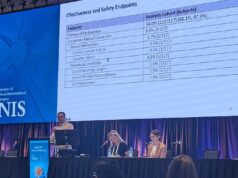
A retrospective analysis of a prospectively maintained database has found that robot-assisted carotid artery stenting (CAS) is both safe and effective. Writing in Neurosurgical Focus, the analysis’ authors also state that the learning curve for robotic procedures was overcome within a short period of time and with relatively few cases at their high-volume cerebrovascular centre.
Fadi Al-Saiegh, Rawad Abbas and Pascal Jabbour (Department of Neurological Surgery, Thomas Jefferson University Hospital, Philadelphia, USA), and colleagues, begin by noting that—over the past two decades—robots have been increasingly used in surgeries to help overcome human limitations, and perform precise and accurate tasks. And, given that the CorPath GRX robotic-assisted system (Corindus) recently gained US Food and Drug Administration (FDA) approval for peripheral vascular and extracranial interventions, they set about evaluating the operational learning curve for CAS procedures with this device over a 19-month period.
Their analysis was conducted at a single institution—the Thomas Jefferson University Hospital—from December 2019 to June 2021 and identified 14 consecutive patients who underwent CAS during this time period. The metrics for proficiency were the total fluoroscopy and procedure times, contrast volume used, and radiation dose. In an effort to evaluate operator progress, the authors report, the patients were divided into three groups based on the study period.
All 14 of the patients included in the analysis received balloon angioplasty and stent placement, and their median degree of stenosis was 95%, the authors add. Ten of these patients (71%) were operated on via the transradial approach and four (29%) underwent a transfemoral approach—with all of the procedures ultimately being completed successfully. No procedural (technical- or access site-related) complications were observed and the median length of hospital stay was 4.5 days.
Discussing results, the authors report that the median contrast volume used was 80ml and the median radiation dose was 38,978.5mGy/cm2. The overall median fluoroscopy and procedure times were 24.6 minutes and 70.5 minutes, respectively. They also note that subgroup analysis showed a significant decrease in these times from 32 minutes and 86 minutes, respectively, in group one and to 21.9 minutes and 62 minutes, respectively, in group three.
“As with any new technology or technique, there is a learning curve to overcome,” the authors state. “We conducted a learning curve analysis and chose objective metrics including contrast volume, procedure and fluoroscopy times, and radiation dose. Our results showed a statistically significant decrease in fluoroscopy time between the first five robot-assisted carotid artery stents and the last five. A similar, statistically significant decrease in procedure time was noted as well.
“Although not statistically significant, our study results also show a trend toward reduced radiation dose and contrast volume, signifying quicker procedures and further indicating a favourable learning curve that can be overcome with continued use.
“Due to the numerous advantages that the CorPath GRX robot system provides, it is important that its use is incorporated as a component of neuroendovascular fellowship training whenever possible. This can include formal, proprietary in-service training as well as continuous supervision by faculty to ensure that operator proficiency is achieved. However, the full potential of robotics in neuroendovascular surgery has yet to be achieved and future clinical studies are needed to consolidate its role in the future of neurological surgery.”
Speaking to NeuroNews following publication of the study, Al-Saiegh pointed out that robotics could play a major role in the future of endovascular surgery—particularly in remote stroke care. “Using robot-assisted neuroendovascular surgery allows qualified operators to perform mechanical thrombectomy remotely,” he said. “This is important when patients who live in rural regions experience a stroke with no immediate access to a thrombectomy-capable centre. It will allow the transport of those patients to a local hospital to undergo mechanical thrombectomy, which is performed robotically by an off-site operator. Technical difficulties and regulatory challenges have yet to be overcome; however, this is the first step to remote, robotic-assisted stroke care.”










